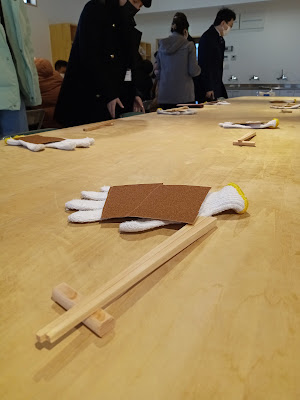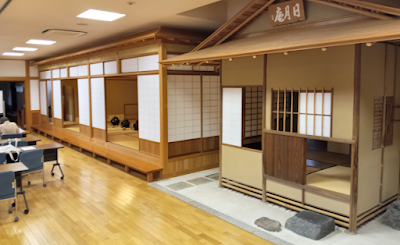Day 5, Echoing the craftsmanship of Ise Jingu this morning
 |
| shaping chopsticks, then burning a pattern in the wood |
The weather was brilliant blue skies with strong gusts of wind on and off. So after the group dispersed at the station near the hotel it was a good chance to walk around the city center in search of the Ise city library. A helpful staff member there kindly showed some of the collections of photo postcards from 100 or more years ago, as well as maps and other illustrations of the city in earlier generations.
 |
bike shelter in front of the Ise library on Saturday afternoon |
Impressive natural features like mountains, boulders, moving or still water, massive trees and so on attract people's attention and can elicit some reverent awe. But the wabi-sabi feelings of this video clip in this winter afternoon sun on the quiet neighborhood houses seems to be an un-Shinto situation: not a place of power and possibility, but a case of dissipating creative energy.
In conclusion, there are a number of things abhorrent or incompatible with Shinto's love of sincere uprightness, purity of heart, and absence of impurity. Those things could be called anti-Shinto. But now looking at the atmosphere of this video clip, perhaps places in this light present a kind of "least" Shinto; the opposite of the "maximum" Shinto concentrated at worship sites governed by human routines or ones "in the wild" that persist with or without people being involved (Niagara Falls could be an example in North America, for instance). If all this logic is true, then the cultural and natural landscape can include situations that are maximum, minimum, and also ones that are anti-Shinto. Looking at things this way, the daily route one takes could touch all these conditions; the Way of Kami is not restricted to days when rituals are performed, matsuri are held, or sampai (paying respects) is offered inside the boundaries of sacred spaces.


Comments
Post a Comment